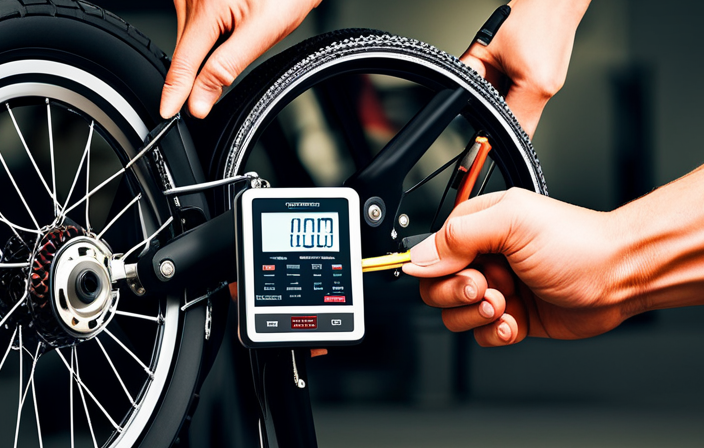Were you aware that the sales of electric bikes have been rapidly increasing in recent years, with a 145% surge in the United States alone?
If you’re curious about joining the growing community of electric bike riders, you’ve come to the right place.
In this article, I’ll guide you through the steps to start riding an electric bike, from choosing the right bike for your needs to exploring new places and enjoying the myriad benefits of electric biking.
Get ready to embark on an exciting and eco-friendly journey!
Key Takeaways
- Proper maintenance is crucial for optimal performance and safety of an electric bike, including maintaining proper tire pressure and regularly charging the battery.
- Bike care and cleaning should be done to remove dirt and debris, ensuring the longevity of the bike.
- Planning and exploration are important aspects of starting to ride an electric bike, including route planning and finding bike-friendly paths and trails.
- Joining a community or group can enhance the riding experience by connecting with fellow riders, learning from experienced riders, and participating in group rides and events.
Determine Your Riding Needs and Goals
Before you start riding an electric bike, it’s important to determine your riding needs and goals. Understanding your riding preferences is crucial in choosing the right electric bike for you.
Are you looking to commute to work or school? Do you plan to use the bike for leisurely rides on weekends? Knowing the purpose of your electric bike will help you make an informed decision. Consider factors such as distance, terrain, and speed requirements.
If you need to tackle hilly terrains, you might want to invest in a bike with a more powerful motor. On the other hand, if you plan to ride mostly on flat surfaces, a bike with a smaller motor may suffice.
By determining your riding needs and goals, you can ensure that you choose the right electric bike that perfectly suits your preferences and requirements for an exciting and enjoyable ride.
Choose the Right Electric Bike
To get going on your e-bike, make sure you select the perfect electric bicycle for your needs. When choosing the right electric bike, it’s important to consider the features that are most important to you. Some key features to look for include the motor power, battery range, and the type of pedal assist system. Additionally, consider the terrain you’ll be riding on and whether you’ll need a bike with suspension or off-road capabilities.
To help you in your decision-making process, here is a table comparing some popular electric bike brands:
| Brand | Motor Power | Battery Range | Pedal Assist System |
|---|---|---|---|
| XYZ | 500W | 40 miles | 5 levels |
| ABC | 750W | 60 miles | 3 levels |
| DEF | 350W | 30 miles | 4 levels |
| GHI | 250W | 20 miles | 6 levels |
By carefully considering these features and exploring different electric bike brands, you can find the perfect e-bike that suits your riding needs and goals. Now, let’s move on to learning the basics of electric bike technology.
Learn the Basics of Electric Bike Technology
When it comes to electric bike technology, it is important to understand how the motor and battery work together. The motor is responsible for providing the power to propel the bike, while the battery supplies the energy to the motor.
By familiarizing yourself with this dynamic duo, you can better appreciate the seamless integration of power and performance.
Additionally, it is crucial to become acquainted with the different levels of pedal-assist available on electric bikes. These levels determine the amount of assistance the motor provides while you pedal, allowing you to customize your riding experience to your desired level of exertion.
So, whether you’re looking for a boost on those uphill climbs or prefer a more challenging workout, understanding pedal-assist levels will help you optimize your electric bike experience.
Understand how the motor and battery work together
First, you’ll want to grasp how the motor and battery work together to power your electric bike.
-
The motor efficiency plays a crucial role in determining how efficiently your bike converts electricity into motion, so it’s essential to choose a high-quality motor that maximizes energy usage.
-
The battery range refers to the distance your bike can travel on a single charge. Understanding the battery’s capacity and how it interacts with the motor will help you plan your rides accordingly.
-
The motor and battery work in harmony, with the motor drawing power from the battery to propel the bike forward. It’s important to ensure that both components are properly maintained and charged to optimize performance.
-
Regularly monitoring the battery level and motor efficiency will help you gauge when it’s time to recharge or replace components.
Understanding how the motor and battery collaborate sets the foundation for your electric bike journey. Familiarize yourself with the different levels of pedal-assist to further enhance your riding experience.
Familiarize yourself with the different levels of pedal-assist
Get to know the various levels of pedal-assist to enhance your riding experience.
Electric bikes come with different pedal assist levels, allowing you to adjust the amount of assistance you receive from the motor as you pedal. These levels can typically be adjusted using a control panel on the handlebars.
The different pedal assist levels determine how much power the motor provides, with higher levels offering more assistance and lower levels requiring more effort from the rider. By experimenting with the pedal assist settings, you can find the level that suits your riding style and preferences.
Once you have familiarized yourself with the different levels, you can move on to the next section and practice riding while getting acquainted with the bike controls.
Practice Riding and Familiarize Yourself with Bike Controls
To start riding an electric bike, you should begin by practicing and getting familiar with the bike controls. Bike handling is crucial for a smooth and enjoyable ride. Take some time to understand how the electric motor assists your pedaling and experiment with different levels of pedal-assist. This will help you find the right balance of power and effort.
Additionally, focus on your riding techniques, such as how to shift gears smoothly and how to brake effectively. As you practice, you’ll become more confident in controlling the bike and navigating different terrains.
Once you feel comfortable with the bike controls and riding techniques, you can move on to the next step: observing safety precautions. Remember, safety should always be a priority when riding an electric bike.
Observe Safety Precautions
After spending some time practicing riding and familiarizing myself with the controls of my electric bike, it is now crucial to shift my focus towards safety precautions.
Safe riding is paramount to ensure a smooth and enjoyable experience on the road. To protect myself from potential accidents and injuries, I highly recommend investing in proper protective gear. This includes a sturdy helmet, elbow and knee pads, and gloves. These protective measures can significantly reduce the impact of falls or collisions.
Additionally, it is essential to follow all traffic rules and regulations, signal intentions clearly, and stay vigilant of my surroundings. To paint a picture for you, imagine yourself confidently cruising down the bike lane, wearing a helmet and protective gear, while being aware of the traffic flow and using hand signals to communicate with fellow riders and drivers.
By prioritizing safety, I can fully embrace the exhilarating thrill of riding an electric bike.
Now, let’s dive into the next section and learn how to maintain and care for our electric bikes.
Maintain and Care for Your Electric Bike
When it comes to maintaining and caring for my electric bike, there are a few key points I always keep in mind.
First, I make sure to regularly check and inflate the tires to ensure optimal performance and prevent any potential issues on the road.
Second, I always keep the battery charged, as a fully charged battery not only extends the bike’s range but also improves its overall efficiency.
Lastly, I make it a point to clean my bike regularly, not only to keep it looking its best but also to prevent any dirt or debris from causing unnecessary wear and tear.
Taking these steps helps me ensure that my electric bike stays in top shape and allows me to enjoy my rides to the fullest.
Regularly check and inflate tires
Before starting your ride, always make sure to check and inflate the tires of your electric bike regularly. Proper tire pressure is crucial for a smooth and safe ride. Here are three reasons why you should prioritize this task:
-
Improved Performance: Maintaining the correct tire pressure ensures optimal traction and stability, enhancing your overall riding experience. It allows you to maneuver easily and confidently on various terrains.
-
Increased Battery Life: When your tires are properly inflated, your electric bike requires less effort to move forward. This reduces strain on the battery, extending its lifespan and allowing you to enjoy longer rides.
-
Enhanced Safety: Well-inflated tires provide better control, especially when cornering or braking. They also minimize the risk of punctures and flats, ensuring a safer journey.
By regularly checking and inflating your tires, you can maximize your electric bike’s performance, safety, and longevity. Once you’ve taken care of the tires, it’s time to move on to the next essential steps: keeping the battery charged and cleaning the bike regularly.
Keep the battery charged and clean the bike regularly
To maintain optimal performance, it’s important to regularly charge the battery and keep the bike clean.
Battery maintenance is crucial for ensuring that you have enough power to enjoy your rides. Make it a habit to charge the battery after each use, and avoid letting it fully discharge. By doing this, you’ll extend the lifespan of the battery and maximize its efficiency.
Additionally, cleaning your electric bike regularly is essential for its longevity. Remove any dirt, dust, or debris from the frame, wheels, and other components. Use a gentle cleaning solution and a soft cloth to avoid scratching the bike. Not only will this keep your electric bike looking great, but it will also help prevent any potential damage.
Now, let’s move on to the next step and plan your routes to explore new places.
Plan Your Routes and Explore New Places
Explore new places and plan your routes to make the most of your electric bike riding experience. Not only does this allow you to discover hidden gems and scenic spots, but it also adds excitement and variety to your rides. When planning your routes, consider factors such as distance, elevation, and terrain. Look for bike-friendly paths and trails that cater to electric bikes, as well as interesting landmarks or attractions along the way. To help you visualize the possibilities, take a look at the table below:
| Route | Distance (miles) | Elevation Gain (feet) | Terrain |
|---|---|---|---|
| Coastal Loop | 20 | 500 | Mostly flat |
| Mountain Ride | 15 | 1200 | Hilly |
| City Tour | 10 | 200 | Urban |
| Park Explorer | 8 | 300 | Mixed trails |
By exploring new places and planning your routes, you can truly make the most of your electric bike adventure. So why not join a community or group to connect with fellow riders and share your experiences?
Join a Community or Group
Joining a community or group is a great way to connect with fellow riders and share experiences while enjoying your electric bike adventure. It’s exciting to meet like-minded individuals who share the same passion for electric biking. By joining events organized by the community, you can participate in group rides and explore new trails together. It’s a fantastic opportunity to learn from experienced riders and discover hidden gems in your area.
Additionally, finding riding buddies through the community can make your rides safer and more enjoyable. You can plan group rides, exchange tips on maintenance and upgrades, and even organize friendly competitions. Riding with others not only enhances your skills but also creates lifelong friendships.
So, hop on board and join a community or group to make the most of your electric bike experience.
Now, let’s talk about how you can upgrade and customize your electric bike.
Upgrade and Customize Your Electric Bike
Upgrading and customizing your e-bike allows you to personalize and enhance your riding experience. There are various upgrade options available that can make your electric bike even better.
You can start by upgrading the battery to increase its range and power. This will allow you to go on longer rides without worrying about running out of battery.
Another option is to upgrade the motor, which can give you a higher top speed and more torque for better performance.
Additionally, you can make personalized modifications to your e-bike, such as adding a comfortable seat, installing a rear rack for carrying items, or attaching fenders to protect yourself from mud and water.
By upgrading and customizing your electric bike, you can create a ride that is tailored to your specific needs and preferences. This will ultimately enhance your overall riding experience and make it even more enjoyable.
Now, let’s move on to the next section and explore how you can enjoy the benefits of electric biking.
Enjoy the Benefits of Electric Biking
To fully experience the advantages of electric biking, you can take advantage of the many benefits it offers.
Here are three reasons why electric biking is a great choice:
-
Electric bike maintenance is a breeze: Unlike traditional bikes, electric bikes require minimal maintenance. With fewer moving parts and a simpler design, maintaining an electric bike is easy and cost-effective. This means more time riding and less time worrying about repairs.
-
Health benefits of electric biking: Electric biking is a fantastic way to improve your fitness and overall health. By providing assistance when needed, electric bikes allow riders of all fitness levels to enjoy the benefits of cycling. Whether you’re recovering from an injury or looking to increase your stamina, electric biking can help you achieve your fitness goals.
-
Environmental friendliness: Electric bikes are eco-friendly alternatives to traditional transportation options. By opting for an electric bike instead of a car or public transportation, you can reduce your carbon footprint and contribute to a cleaner and healthier planet.
Incorporating electric biking into your lifestyle not only brings convenience and health benefits but also allows you to make a positive impact on the environment. So hop on your electric bike and start enjoying the ride!
Frequently Asked Questions
Can I ride an electric bike without any prior experience?
Yes, you can ride an electric bike without any prior experience. Electric bikes are designed to be user-friendly and safe. They provide a fun and easy way to explore while reaping the benefits of exercise and eco-friendly transportation.
How long does it take to charge an electric bike’s battery?
Charging time for an electric bike’s battery varies depending on its capacity. Generally, it takes around 4-6 hours to fully charge a standard e-bike battery, allowing for hours of enjoyable riding.
Are electric bikes legal to ride on public roads?
Yes, electric bikes are legal to ride on public roads in most countries. They offer a safe and eco-friendly way to commute, with benefits like reduced emissions and improved health.
What is the average lifespan of an electric bike?
The average lifespan of an electric bike depends on various factors, such as regular electric bike maintenance and usage. Just like with any other machine, taking care of it and using it responsibly will ensure it lasts longer.
Can I ride an electric bike in rain or snow?
Yes, you can ride an electric bike in rain or snow. To do so, ensure your bike is properly maintained, including checking the tires, brakes, and chain. Additionally, use fenders, wear appropriate clothing, and be cautious of slippery surfaces.
Conclusion
So there you have it, folks!
Riding an electric bike is like soaring on the wings of freedom, effortlessly gliding through the streets and exploring new horizons.
With the right bike, a bit of practice, and a dash of adventure, you’ll be zipping along with a smile on your face and the wind in your hair.
So go ahead, embrace the electric revolution and let the joy of electric biking take you to places you’ve never been before.
Happy riding!









